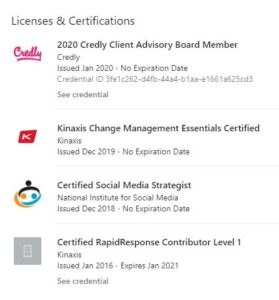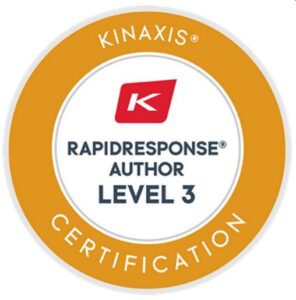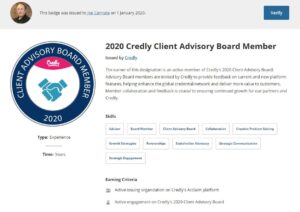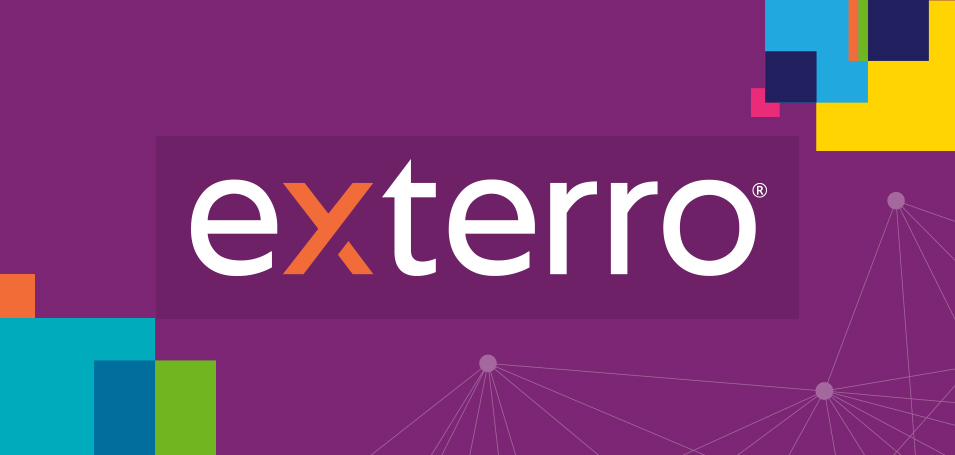While plenty has been written about how digital badges can improve learner engagement and one’s personal brand, far less coverage has been given to how it benefits the businesses that offer the badges. I’m going to share a story with you that I recently heard from a certification director about how the use of digital badges advances brand awareness at his software-as-a-service company, thereby boosting business performance.
Digital Badges for a Skills Era
Here’s a quick background on digital badges, which have really grown in popularity particularly in the online education space in the last few years. Digital badges, sometimes referred to as open badges or microcredentials, serve as a useful way to engage and recognize accomplishments as part of an online program, and at the more sophisticated end of the spectrum, they can also convey professional skill sets or achievements to one’s network, potential employers, or manager.
For example, IBM runs a digital credential program to recognize anybody, as an example, who completes IBM courses on data science and passes end-of-course assessments, verifying their skills. For IBM’s own employees, the company also offers more than 2,100 badges tied to programming, project management, education, selling, presenting, and even earning a first patent.
The digital badge is more than just a little image that the learner can display on social networks, professional profiles, resumes and email signatures. There’s metadata that lives behind the badge. The idea is that the recipient — the HR director or hiring manager — can click on the badge to view information about what the achievement actually represents as well as the evidence to support the claim.
Digital Badges Drive Product Adoption, Awareness and Loyalty
For companies who deliver online learning, digital badges can also drive learner engagement, and higher adoption of their solution– which is always good for business. Higher adoption and engagement means more brand awareness and loyalty with individual users, and just as importantly, stronger connections with your customers throughout their lifecycle, reducing churn and driving better client or member satisfaction.
To understand the reality of digital badging from someone who implements them professionally, I spoke with Joe Cannata, the Certification Director for Kinaxis, a SaaS company that produces RapidResponse, an enterprise planning and supply chain platform that helps companies manage their supply chains.
Not only has Joe overseen the implementation of digital badging for his company, he has earned a badge or two himself. If you were to look up Joe through his LinkedIn profile and scroll down to the section on “Licenses & Certifications,” you’d find four credentials listed, including two that offer a “See credential” link. One of those was earned by being a client advisory board member for digital badge company Credly and the other was achieved by being a certified RapidResponse Contributor.
These credentials link to pages that list the skills Joe has demonstrated in the course of earning the badge. These range from soft skills like creative problem solving, collaboration, and strategic communication to hard skills that include: editing data, controlling data views and personalizing RapidResponse. You’ll also be able to read the “earning criteria,” what Joe had to do to get the badge.
Digital Badges versus Paper Certificates
Joe was instrumental in getting his company’s digital badging program off the ground in September 2019. As he recently told me, “That was a huge success for us. People love to get their badges and show them off.” The Kinaxis badging program is offered to members of the Kinaxis staff, Kinaxis’ customers and those who work for its extended enterprise, consultants in partner companies who do the implementation work for the companies that are ultimately using the software.
The benefit of the badge over a “paper certificate is that “the certificate doesn’t tell the full story; the digital badge does,” Joe suggests. “A digital badge is a representation of achievement backed by a set of skills and a route to earn those skills and with verifiable metadata, including who issued it, when, and how long it’s valid.”
Digital Badges popularity rests in their appeal to human nature. Who doesn’t want to display skills and highlight achievements to colleagues, friends, peers and hiring managers? The case for implementing a program may not be as clear.
According to Joe, digital badges provide “great exposure for the corporate brand” in three ways:
- When someone earns a digital badge, Joe creates a congratulatory post about the feat in LinkedIn. Those posts are liked and shared by others inside and outside the company which magnifies the impact of the achievement while also amplifying the company name and its certifications out into the world. Ultimately, according to Joe, this activity “builds the credibility in the brand of our program, and it also builds the credibility and skills of the consultant. Somebody will say to that person, ‘Oh, yeah. I saw you on LinkedIn. You achieved that badge.’ It creates a stickiness, which is important.”
- Customers looking to hire a company to help them with their SaaS deployments will take into account the number of credential holders a given implementation provider has. “In the old days, customers would ask for resumes of consultants for a project. The number of people certified, and to which level, is definitely a factor when customers make decisions on which partner to choose.” Now it’s badges, says Cannata. Customers “look at that like a recruiter would.” By promoting badges, you help your partners put their best face forward.
- Digital badges are the preference of new generations of workers. They lead digital lives, and that includes how they portray their professional personas, says Cannata. “I didn’t want our company to look stale and stodgy. Paper and PDF certificates are yesterday, in the room with the fax machines.”
How to Kick Off Your Digital Badge Program
Based on his own experiences at Kinaxis, Joe offers three lessons for getting a digital badge program off the ground quickly.
Choose your badge platform wisely. You can launch a digital badge program using one of two approaches: open source or commercial. With the first, you adopt a specification such as Open Badges, developed by IMS Global Learning Consortium, and build it into your own applications. In the commercial approach, you’ll work with a company like Credly, Accredible, and Badgr, which provides the infrastructure for hosting the digital badge metadata. Do yourself a favor, Joe suggests: Go the second route. The right company can help you generate the badging, consult with you on the skills mapping, assist with the marketing, even design the badges if necessary.
Make noise. When you post information about the latest person to earn a badge, you’re planting the seed for all kinds of good news to grow. At Kinaxis, even the leadership is involved. Executives at all levels cheer on those who earn badges by “liking” the posts created by Joe. Such C-level acknowledgement makes an impression, in turn, on the badge recipient.
Get “historic”. To give your program a jumpstart, consider issuing digital badges to anyone who earned a certification prior to the launch date. That’s what Kinaxis did when the company launched its badge program, which has since grown to 25 different badges. No, not everybody will use the badges, usually because they’ve moved on and are no longer involved with the particular technology. But for others, it adds an unexpected perk to getting their certification in the first place.
An Essential Ingredient to Succeed with Digital Badges
While the badging vendor will help you with the myriad details of putting your program together, make sure your learning platform includes the right functionality to get the job done:
- The ability to track and issue the badges earned by learners;
- A leaderboard feature to help you set up friendly competition among people within the enterprise;
- Integration standards to enable you to transfer data between the badging solution and your learning management system.
Digital badging can help you drive learner engagement and improve your business performance while placing your certification efforts firmly in place for future recognition, engagement and performance.
Learn more about digital badging:
- 4 Ways to Bring Value to Professional Learning with Awards and Certificates
- Incorporating Gamification into the Learning Experience






